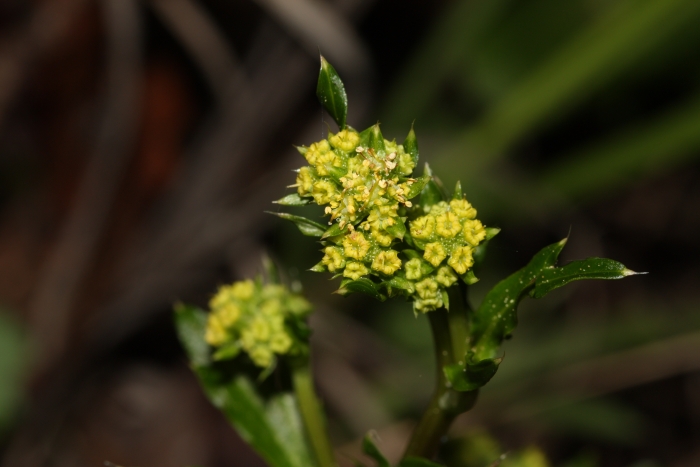Pacific Blacksnakeroot
(Sanicula crassicaulis)
Pacific Blacksnakeroot (Sanicula crassicaulis)
/
/

Walter Siegmund (talk)
CC BY-SA 3.0
Image By:
Walter Siegmund (talk)
Recorded By:
Copyright:
CC BY-SA 3.0
Copyright Notice:
Photo by: Walter Siegmund (talk) | License Type: CC BY-SA 3.0 | License URL: https://creativecommons.org/licenses/by-sa/3.0 | Uploader: Wsiegmund | Publisher: Wikimedia Commons | Title: Sanicula_crassicaulis_6728.JPG | Notes: User created page with UploadWizard |















































Estimated Native Range
Summary
Sanicula crassicaulis, commonly known as Pacific Blacksnakeroot, is a semi-deciduous perennial herb native to coastal woodlands and forest understories of the Pacific Northwest , Mexico and South America. It can grow up to 1.2 meters tall and emerges from a taproot. The plant features an inflorescence of one or more heads of bisexual and male-only flowers, with tiny, curving, yellow petals that are not particularly showy. Each flower head is subtended by about five leaflike, lance-shaped bracts. The rounded fruits are notable for being covered in curving prickles and are borne in small clusters.
Pacific Blacksnakeroot is appreciated for its adaptability to various light conditions and its moderate water needs, making it a suitable choice for woodland gardens, naturalized areas, and as an understory plant in shaded landscapes. It thrives in full sun to part shade and prefers soils with medium to fast drainage. While not known for its flowers, the prickly fruits add textural interest to the plant. It is relatively low maintenance but may require some water during prolonged dry periods. Gardeners should be aware that it can self-seed and spread, potentially becoming weedy in ideal conditions.CC BY-SA 4.0
Pacific Blacksnakeroot is appreciated for its adaptability to various light conditions and its moderate water needs, making it a suitable choice for woodland gardens, naturalized areas, and as an understory plant in shaded landscapes. It thrives in full sun to part shade and prefers soils with medium to fast drainage. While not known for its flowers, the prickly fruits add textural interest to the plant. It is relatively low maintenance but may require some water during prolonged dry periods. Gardeners should be aware that it can self-seed and spread, potentially becoming weedy in ideal conditions.CC BY-SA 4.0
Plant Description
- Plant Type: Herb
- Height: 2-3 feet
- Width: 1-2.5 feet
- Growth Rate: Moderate
- Flower Color: Yellow
- Flowering Season: Spring
- Leaf Retention: Semi-Deciduous
Growth Requirements
- Sun: Full Sun, Part Shade
- Water: Low, Medium
- Drainage: Medium, Fast
Common Uses
Bee Garden, Butterfly Garden, Drought Tolerant, Low Maintenance
Natural Habitat
native to coastal woodlands and forest understories of the Pacific Northwest , Mexico and South America
Other Names
Common Names: Pacific Black-Snakeroot, Pacific Sanicle, Western Sanicle, Western Snakeroot, Sanicle À Tige Charnue
Scientific Names: , Sanicula crassicaulis, Sanicula menziesii, Sanicula diversiloba, Sanicula menziesii var. pedata, Aulosolena crassicaulis, Aulosolena menziesii, Sanicula crassicaulis var. genuina, Sanicula crassicaulis var. menziesii, Sanicula howelliae
GBIF Accepted Name: Sanicula crassicaulis Poepp. ex DC.